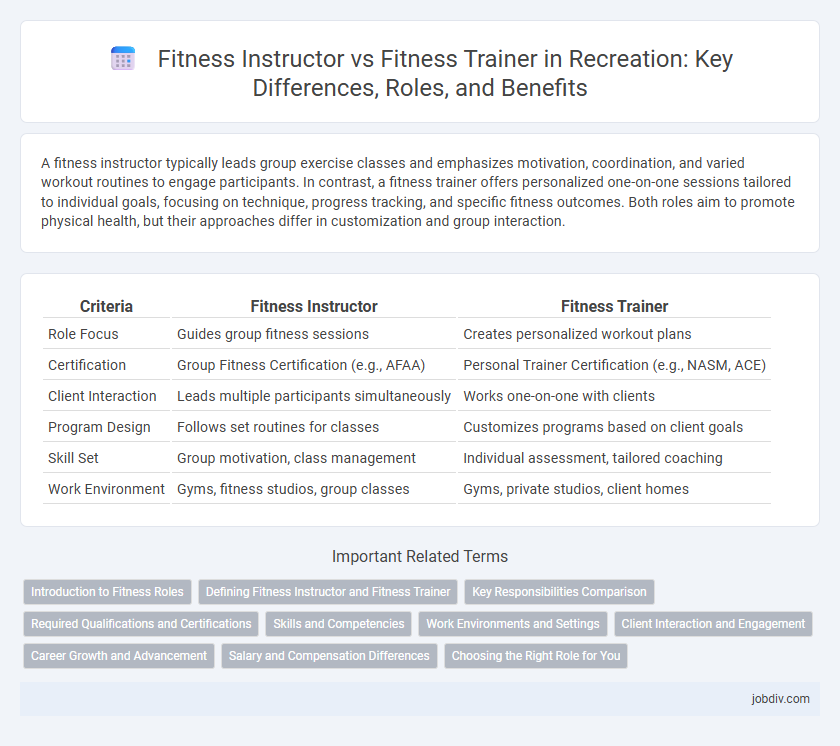A fitness instructor typically leads group exercise classes and emphasizes motivation, coordination, and varied workout routines to engage participants. In contrast, a fitness trainer offers personalized one-on-one sessions tailored to individual goals, focusing on technique, progress tracking, and specific fitness outcomes. Both roles aim to promote physical health, but their approaches differ in customization and group interaction.
Table of Comparison
| Criteria | Fitness Instructor | Fitness Trainer |
|---|---|---|
| Role Focus | Guides group fitness sessions | Creates personalized workout plans |
| Certification | Group Fitness Certification (e.g., AFAA) | Personal Trainer Certification (e.g., NASM, ACE) |
| Client Interaction | Leads multiple participants simultaneously | Works one-on-one with clients |
| Program Design | Follows set routines for classes | Customizes programs based on client goals |
| Skill Set | Group motivation, class management | Individual assessment, tailored coaching |
| Work Environment | Gyms, fitness studios, group classes | Gyms, private studios, client homes |
Introduction to Fitness Roles
Fitness instructors primarily lead group exercise classes and provide general guidance on workout techniques, emphasizing motivation and proper form to enhance overall group performance. Fitness trainers develop personalized fitness programs tailored to individual clients' goals, often incorporating detailed assessments and progress tracking to ensure effective results. Both roles require strong knowledge of anatomy, exercise physiology, and client communication to promote safe and effective fitness practices.
Defining Fitness Instructor and Fitness Trainer
A Fitness Instructor specializes in guiding group exercise sessions, focusing on proper form and motivational techniques to enhance participants' physical activity experiences. A Fitness Trainer provides personalized workout plans and one-on-one coaching, designing programs tailored to individual fitness goals and health conditions. Both roles require knowledge of exercise science, but a trainer typically offers more customized fitness and rehabilitation strategies.
Key Responsibilities Comparison
Fitness instructors primarily lead group exercise classes and demonstrate workout techniques to ensure proper form and safety, while fitness trainers develop personalized training programs tailored to individual client goals. Instructors focus on motivating large groups and maintaining class structure, whereas trainers provide one-on-one coaching, progress tracking, and customized fitness assessments. Both roles require expertise in anatomy and exercise science but differ in client interaction scope and program customization depth.
Required Qualifications and Certifications
Fitness instructors often need a certification from reputable organizations such as ACE, ACSM, or NASM, focusing on group exercise leadership and basic personal training knowledge. Fitness trainers require more advanced certifications, including specialized credentials like Certified Strength and Conditioning Specialist (CSCS) or National Strength and Conditioning Association (NSCA) certifications, emphasizing personalized training programs and in-depth anatomy knowledge. Both roles demand CPR and AED certification, but fitness trainers typically pursue ongoing education to maintain their expertise in client-specific fitness goals.
Skills and Competencies
Fitness instructors excel in guiding group workouts, demonstrating proper exercise techniques, and ensuring safety, emphasizing communication and motivational skills. Fitness trainers specialize in creating personalized workout plans, assessing individual needs, and tracking progress, highlighting analytical skills and knowledge of anatomy. Both roles require certification, but trainers often possess a deeper understanding of exercise science and client-specific fitness strategies.
Work Environments and Settings
Fitness instructors primarily work in group exercise settings such as gyms, community centers, and fitness clubs, leading classes like yoga, Pilates, or spin. Fitness trainers often provide personalized sessions in private studios, clients' homes, or specialized training facilities, focusing on tailored workout plans and one-on-one coaching. Both professionals adapt their work environments to meet client needs, with trainers more frequently operating in individualized or small-group environments for focused results.
Client Interaction and Engagement
Fitness instructors focus on group classes, delivering standardized workouts that motivate large audiences, while fitness trainers develop personalized programs tailored to individual clients' goals and needs. Trainers engage clients through one-on-one coaching, providing detailed feedback and adjustments to improve technique and performance. Client interaction with trainers typically involves continuous progress tracking and personalized encouragement, fostering a deeper, more supportive relationship.
Career Growth and Advancement
Fitness instructors primarily lead group exercise sessions, focusing on teaching proper techniques and motivating participants, while fitness trainers provide personalized workout plans and one-on-one coaching tailored to individual goals. Career growth for fitness instructors often involves progressing to senior instructor roles or specializing in niche fitness areas, whereas fitness trainers can advance by gaining certifications in specialized training, nutrition, or rehabilitation, potentially moving into roles such as wellness coaches or fitness directors. Both career paths benefit from continuous education and networking, which are crucial for staying competitive and achieving long-term advancement in the recreation and fitness industry.
Salary and Compensation Differences
Fitness instructors typically earn an average salary ranging from $35,000 to $50,000 annually, focusing on group classes and general wellness guidance, whereas fitness trainers often command higher compensation between $45,000 and $70,000 due to personalized client training and specialized certifications. According to the Bureau of Labor Statistics, fitness trainers with advanced credentials and experience in areas like strength conditioning or rehabilitation tend to secure premium pay and bonuses. Furthermore, trainers working in private facilities or offering one-on-one coaching generally receive higher hourly rates and performance-based incentives compared to instructors employed in community centers or gyms.
Choosing the Right Role for You
Fitness instructors typically lead group exercise classes, focusing on motivation and energy to engage participants, while fitness trainers provide personalized workout plans and one-on-one coaching tailored to individual goals. When choosing the right role, consider your preference for group interaction versus individualized training and your expertise in designing customized fitness programs. Certifications like ACE, NASM, or ACSM enhance credibility and open career opportunities in both paths.
Fitness Instructor vs Fitness Trainer Infographic

 jobdiv.com
jobdiv.com